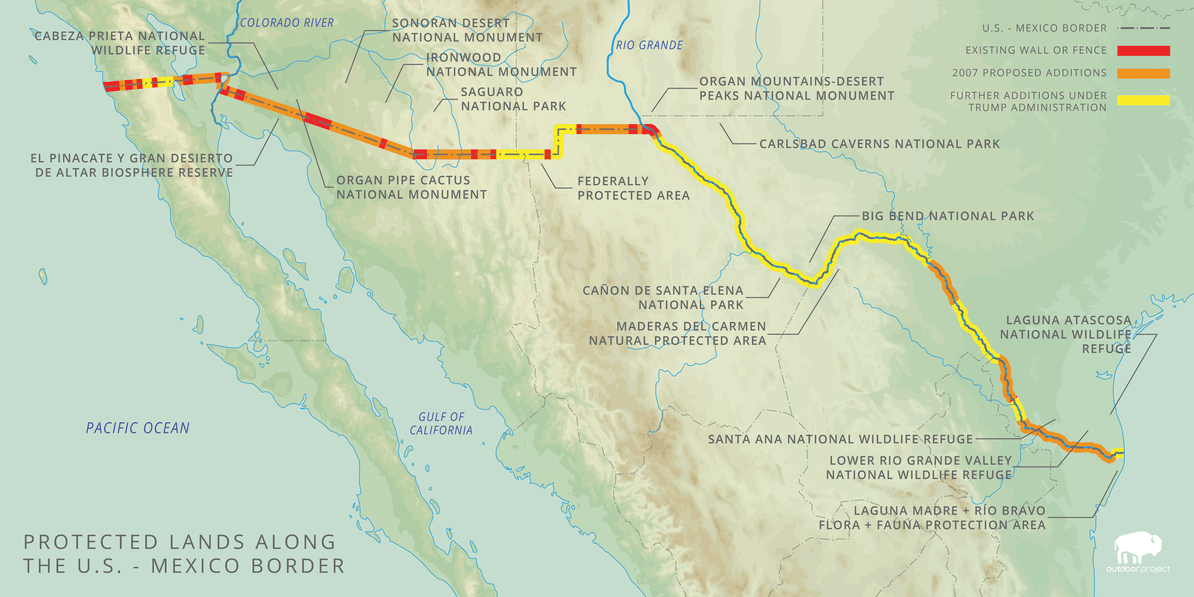You are here
While 9/11 may have been the impetus for the largest fence-building frenzy in the United States, the first fence construction efforts actually began in 1990 with a 66-mile steel barrier moving east from the Pacific Ocean just south of San Diego. Unfortunately, this rather short section of fence was not the last. Following the 9/11 terrorist attacks, President George W. Bush signed into effect the Secure Fence Act with the aim of constructing 700 miles of additional fence on the border between the U.S. and Mexico. Under Department of Homeland Security oversight, 36 major federal regulatory acts were waived in an attempt to expedite this goal. The environmental laws pushed aside included the Clean Water Act, Endangered Species Act, Migratory Bird Treaty Act, and the National Historic Preservation Act, to name just a few. Environmental organizations like The Sierra Club and Defenders of Wildlife protested mightily, but they won mostly small victories.
In 2010, fencing was put on hold and environmental groups on both sides of the border breathed a sigh of relief. Now, with the arrival of President Trump in office and a Republican-held Congress, the threat to wildlife has returned. With an executive order signed in his first full week in office, President Trump has doubled down on his promise to finish the wall separating the U.S. from Mexico. While the human impact cannot be understated, the much-less-discussed impact on wildlife will also have potentially catastrophic results.

The majority of the still-open border lies along the eastern half of the line. When construction in Texas first began in 2009, according to Newsweek, the Texas Parks and Wildlife Department prepared a list of potentially affected species that included 10 endangered plant and animals species, nearly two dozen threatened species, and dozens of species of concern. In spite of these valid and serious concerns, the wall was built anyway.
The effects of the wall as it currently stands have been dramatic. In just the Rio Grande Valley of Texas alone, three national wildlife refuges have had their habitats cut by the fencing projects and associated destruction caused by construction. Due to the waiver of environmental law requirements, DHS did not look at the ecological impacts in these sensitive areas. Because of the sinuous nature of the Rio Grande River (which happens to serve as the border marker between the two countries) and treaties that forbid construction on its flood plains, the straight-line fencing has created isolated pockets of no-man’s land between the fence and the river’s edge. Private homes, wildlife sanctuaries, and even golf courses have found themselves on the “wrong” side of the fence. The logic is incomprehensible.
As outdoor recreationalists, we seek out places of natural beauty, rich in wildlife, and diverse in scope. While we may never see the elusive jaguar that roams the “Sky Islands,” a chain of mountain ranges that connects Central America to the Rocky Mountains, or spot a jaguarondi, a small wildcat currently at risk in both Mexico and the U.S., it is upon us to protect their habitats. When small and large predators are removed from an ecosystem, cascading effects ripple through to other plants and animals. Fencing will harm even the tiniest of creatures. Even those animals that can navigate over the fence, like migrating birds, will still have difficulties such as light pollution to contend with. The isolating effects on small populations of endangered animals must also be highlighted. When a tiny remaining population is isolated, the genetic material available for the continuation of the species is reduced as the animals become weakened through inbreeding.
Recreation related to wildlife brings in nearly half a billion dollars to Texas alone, as people are drawn to an area classified by Conservation International as one of only five High Biodiversity Wilderness Areas in the world. Renewed construction will certainly affect the people who enjoy this unusual environmental resource for recreation. Before any new construction takes place, the protocols already in place for the protection of endangered species must be utilized. Environmental Impact Statements from all relevant agencies that comply with the National Environmental Policy Act are a requirement and should not be sacrificed merely to expedite construction. Building this wall will not stop drug smuggling or illegal immigration, or even terrorism. It will, however, stop the natural movement of animals through an incredibly unique ecosystem. A nearly 20-million-year history of ebb and flow in wildlife will be curtailed because of short-sighted policy.
Make your voice heard by reaching out to your representatives, preferably with a phone call. You can easily search for their contact information to express your concerns on current events using tools like the Countable app. Read the executive order in full here. Stay informed and discuss this with your family and friends. Have you visited or traveled near the border? Consider posting your images to social media, with the hashtags #ALYGAD, #resist, and #NoBanNoWall.







Comments
Sign In and share them.